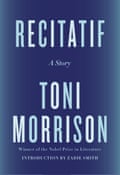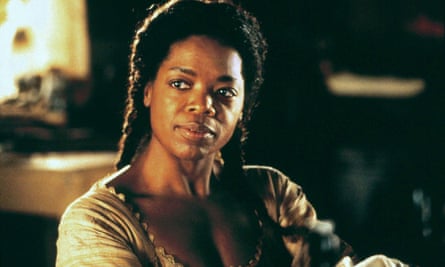Nobel prizewinner Toni Morrison was arguably the greatest American writer of her time, leaving behind an impressive body of boundary-pushing work when she died, aged 88, three summers ago. Maybe her novels have long been sitting on your “to read” pile, or perhaps you’re a lifelong fan who wants to revisit your favourites. Either way, writer Bernice McFadden, whose novel The Warmest December was praised by Morrison herself, can guide you through this brilliant writer’s work.

The entry point:
Toni Morrison might be best known for her 11 novels, but her short story Recitatif has received renewed attention since being published as a standalone volume earlier this year.
Originally published in 1983 in Confirmation: An Anthology of African American Women edited by Amiri Baraka, the 96-page tale tells the story of eight-year-old girls, Twyla, and Roberta, one white and one Black.
The brilliant thing about this story is that it is about race, but Morrison never explicitly mentions that. In fact, we are never told which of the girls is white and which is Black, we are left to intuit it through their behaviours, actions, and reactions.
Recitatif is a compact introduction to her trademark use of language and her layered, lyrical narrative style.
Morrison called Recitatif an experiment. I call it genius.
The book club pick
Many of Morrison’s novels have been called difficult and dense. The truth, I believe, is that critics and the reading public have labelled them as such because Morrison is a such a master at juggling several literary techniques at once, rarely ever dropping the metaphorical ball.
Sula, perhaps the least intricate in Morrison’s catalogue, is the perfect novel to win over anyone who might have struggled with her work before. It’s a complex yet extremely compelling look at two friends, Sula and Nel. They are both such intriguing, fully realised characters that it’s hard not to become invested in them. And while it might be viewed as an “easier” read than, say, Beloved, don’t be fooled into thinking that Sula lacks the complexity, layers and lush language found in Morrison’s other books – there’s plenty for groups of friends to discuss and unpick here.
The most topical one
The HBO series Watchmen turned a spotlight on the Tulsa race massacre of 1921 when angry white mobs destroyed Greenwood – a city district so prosperous they called it Black Wall Street. Bombs were dropped on homes and businesses and innocent Black people were shot in the streets like rabid dogs.
But decades before Watchmen, Toni Morrison penned Paradise, the third novel in the “trilogy” that also includes Beloved and Jazz. The novel is set in the fictitious town of Ruby in Oklahoma; a town that, like Greenwood, was founded by formerly enslaved Black people. Here, the threat to the conservative community is a group of women who have taken up residence in a convent on the edge of town.
Eager to protect their legacy and way of life, nine male leaders set out to rid the town of the independent thinking, non-conforming female menace.
Published in 1998, Paradise was Morrison’s first novel after winning the Nobel prize in literature in 1993 and it was well worth the wait.
As was her custom, Morrison paid humble tribute to the ancestral origins of her characters. In Paradise, she transports the reader all the way back to the founding of Ruby in 1891 and gently moves us into the present-day setting of 1972 – thus creating a story that is powerful, fully realised, and realistic.
And Paradise, apart from anything else, has one of the best first lines of any of Morrison’s novels: “They shoot the white girl first. With the rest they can take their time.”
As with Recitatif, Morrison never disclosed who the white girl is in the story. And that unanswered question remains the topic of hot debate – Morrison herself said that while many readers over the years offered guesses, “only one of them was ever correct”.
The one that deserves more attention
Set in the 1680s when slavery was still in its infancy, A Mercy, Morrison’s ninth novel, focuses on Florens, a young, literate slave who is sold to pay a debt. Florens is crushed by being separated from her mother, and in her new life she attempts time and again to fill the open and aching wound.
Though less widely read than Beloved, A Mercy has plenty in common with Morrison’s most famous book. Here again, the writer examines the intricate and often mystical bonds that exist between mother and daughter. It’s a truly brilliant story that should be much better known.
If you read one, it should be
In Morrison’s first novel, The Bluest Eye, Pecola Breedlove is a little Black girl “who wanted to rise up out of the pit of her blackness and see the world with blue eyes”.
This searing and haunting story explores many things, but mostly it speaks to the oppression, subjugation and the sexual violence carried out against Black women.
The story unfolds in Depression-era America, but the storyline and the themes of incest, colourism and self-hatred would ring true in any period. The novel is a unique piece of literature because it is both timeless and relevant.

The Classic
Many have come to know Morrison’s voice and distinctive style through her Pulitzer award-winning novel, Beloved.
In it, protagonist Sethe escapes the bonds of slavery with her children. Sethe’s former enslaver pursues her and when she spots him coming up the road towards her home, she sets out to murder her children to keep them from being re-enslaved.
Only one child – Beloved - succumbs to her injuries. Years later, she returns as an apparition, haunting Sethe into madness.
The novel is a metaphor and the psychic manifestation of the physical, mental, and emotional horrors suffered by enslaved people.
More than one of Morrison’s books could be classed as masterpieces, but this one is famous for a reason: everyone should read it.
This Bitter Earth by Bernice McFadden is published by Vintage (£9.99). To support the Guardian and Observer order your copy at guardianbookshop.com. Delivery charges may apply.

Comments (…)
Sign in or create your Guardian account to join the discussion